Asia-Pacific Non-Woven Fabric Market Size
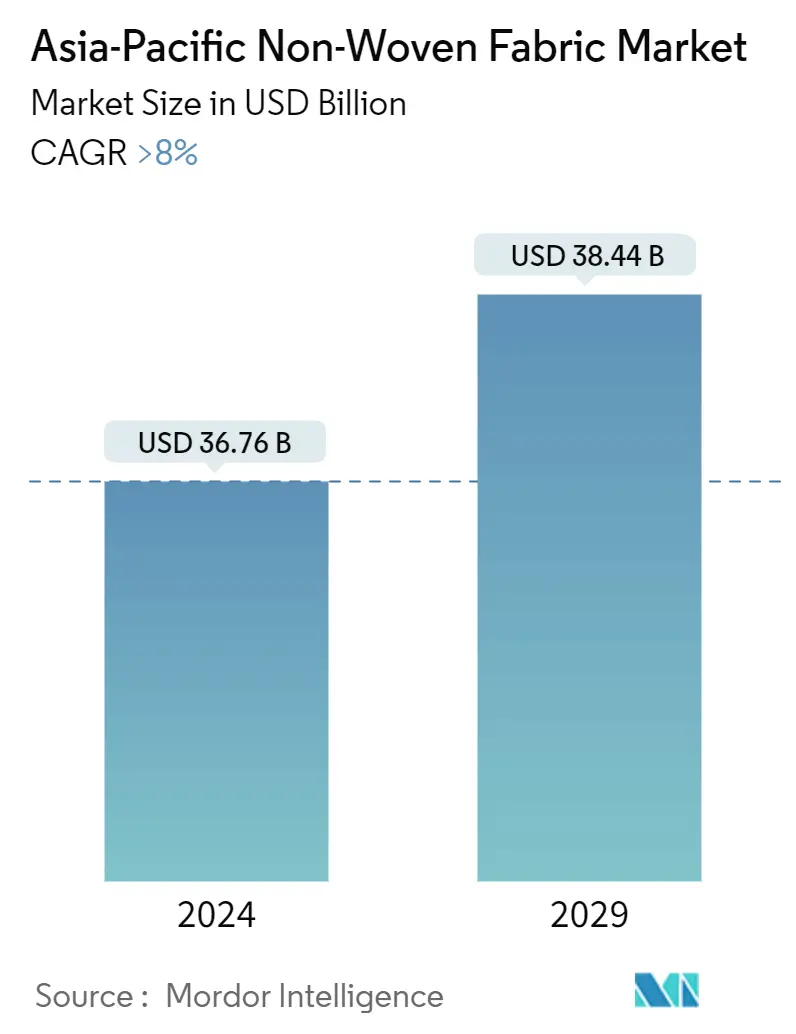
| Study Period | 2019-2029 |
| Base Year For Estimation | 2023 |
| Market Size (2024) | USD 36.76 Billion |
| Market Size (2029) | USD 38.44 Billion |
| CAGR (2024 - 2029) | 8.00 % |
| Market Concentration | High |
Major Players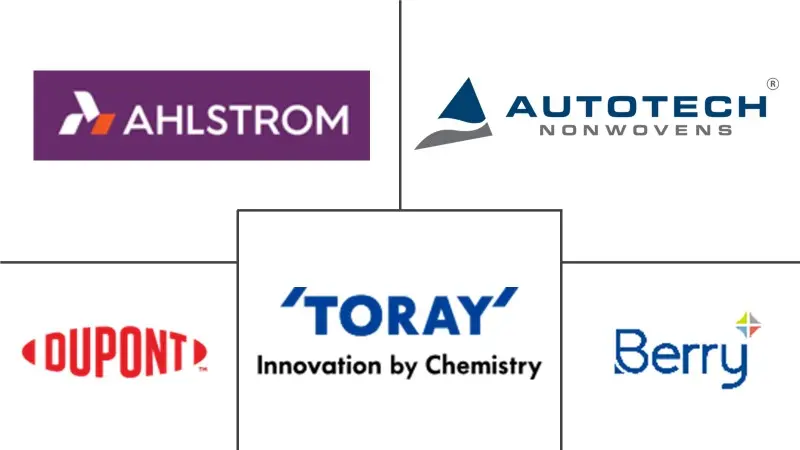
*Disclaimer: Major Players sorted in no particular order |
Asia-Pacific Non-Woven Fabric Market Analysis
The Asia-Pacific Non-Woven Fabric Market size is estimated at USD 36.76 billion in 2024, and is expected to reach USD 38.44 billion by 2029, growing at a CAGR of greater than 8% during the forecast period (2024-2029).
The Asia-Pacific non-woven fabric market is negatively affected by the COVID-19 pandemic. China was the worst hit by the COVID-19 pandemic in the region. The COVID pandemic resulted in lockdowns in China, India, and Japan, which negatively affected the automotive, textiles, and construction industries, thereby affecting the non-woven fabric market. However, the market recovered well after the restrictions were lifted. The market registered a significant growth rate recently due to rising demand for non-woven fabrics in the healthcare, textile, and automotive industries.
- The increasing application base in the healthcare industry, the growth in the automotive industry, and the increasing demand for non-woven fabrics in the textile industry are expected to drive the market for non-woven fabrics.
- The need for more awareness among consumers and the volatility in raw material prices are expected to hinder the market's growth.
- The rising awareness regarding personal care and hygiene industries is expected to provide opportunities for the market during the forecast period.
- China is likely to dominate the market due to the rising demand for non-woven fabrics in the construction, textiles, and healthcare end-user industries. It is also expected to register the highest CAGR during the forecast period.
Asia-Pacific Non-Woven Fabric Market Trends
Healthcare End-User Industry to Dominate The Market
- The non-woven fabric includes a wide range of applications in healthcare products, such as for dressings, surgical masks and gowns, surgical drapes, bedding, and implantable, like with its orthopedic applications, sutures, tissue structures, etc.
- Non-woven fabric is highly beneficial in terms of effectiveness, disposability, adaptability, and cost, with its wide applications in the healthcare industry. Non-woven fabric is one of the most effective materials for bacterial barriers. It is superior to linen in terms of reducing airborne contamination.
- In the Asia-Pacific region, the growing and aging population, rising prevalence of chronic diseases, infrastructure investments, and technological advancements are anticipated to boost the demand for healthcare in the coming years.
- Asia-Pacific is expected to witness a significant increase in the use of hygiene products over the forecast period due to the increasing adoption of female hygiene products in countries like India and China. In India, it is currently estimated that over ~60% of Indian women do not use sanitary care products. It is mainly due to the large population residing in rural areas. With the increase in the penetration rate of sanitary care products, owing to the increasing hygiene precautions, the market for non-wovens in the country is expected to grow rapidly.
- Furthermore, according to IBEF, in 2022, the Indian healthcare sector is expected to witness a three-fold growth. It grew to USD 372 billion in 2022 to USD 110 billion in 2016 witnessing a growth of 22% between 2016–2022. Thus, the growing healthcare industry in the country is expected to drive the demand for non-woven fabric.
- Similarly, in Japan, the healthcare market grew by over 50% over the last 20 years, while GDP grew by less than 10% over the same timeframe. The country holds a total of 179.4 thousand medical care institutions. Such a robust healthcare industry in the country is expected to drive the market for non-woven fabric in the country.
- Hence, owing to the factors mentioned above, the application of non-woven fabrics from the healthcare industry is likely to dominate during the forecast period.
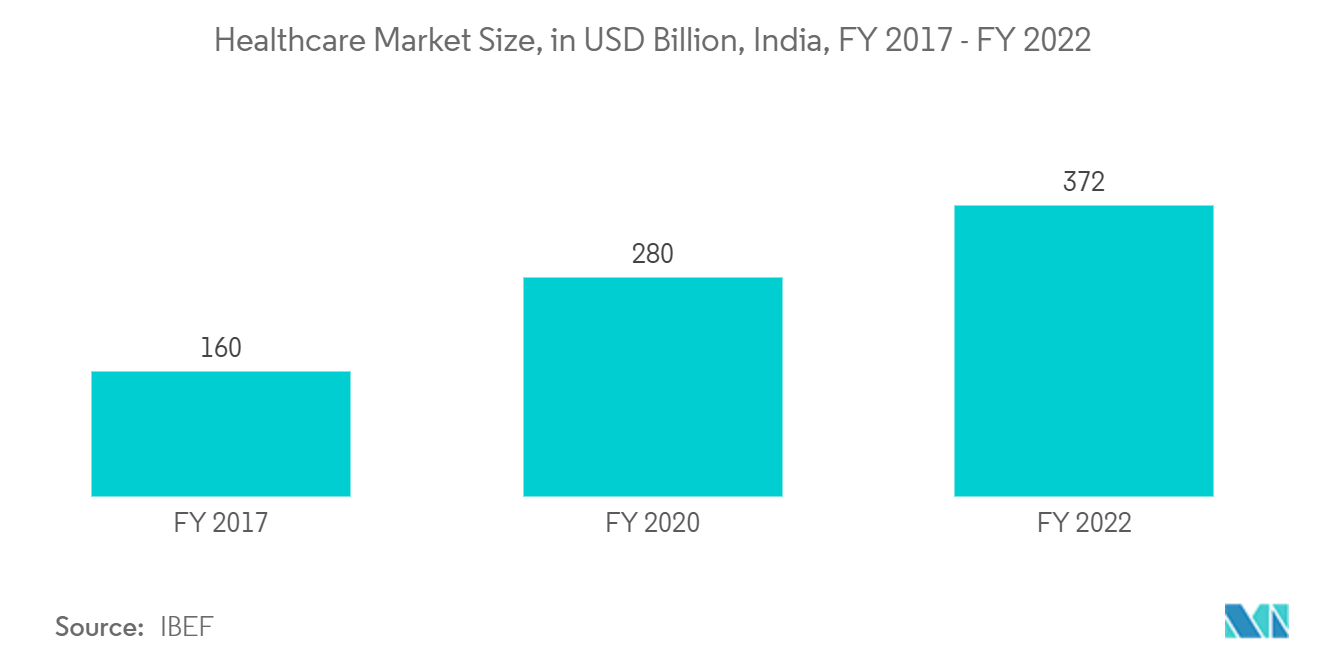
China to Dominate the Market
- China is expected to dominate the market for non-woven fabrics during the forecast period. This is due to the rising demand for non-woven fabrics from the healthcare industry and growing application in the textile industry in this region.
- In the Asia-Pacific region, China is the largest economy in terms of GDP. China is one of the fastest economies and has become one of the biggest production houses in the world. China is the second-largest healthcare market in the world. The country aims to raise the healthcare industry's value to USD 2.3 trillion by 2030, more than twice its size now. The increasing healthcare industry will drive the current studied market in the country.
- In China, the textile industry registered significant market growth. According to the National Bureau of Statistics of China, textile production volume accounted for 38.2 billion m in 2022, compared to 23.5 billion m during the same period in the previous year.
- In 2022, China was the top-ranked global textile exporter, with a value of approximately USD 148 billion. Similarly, the European Union ranked in second place, with an export value of around USD 71 billion. The export value of textiles is further expected to increase in the coming years, thereby driving the current studied market.
- The demand for non-woven fabrics is increasing in the construction industry. According to the National Bureau of Statistics of China, the value of construction output accounted for CNY 31.2 trillion (USD 4.5 trillion) in 2022, up from CNY 29.3 trillion (USD 4.2 trillion) in 2021. China is expected to spend nearly USD 13 trillion on buildings by 2030. The increasing market in the country is expected to drive the market for non-woven fabrics in the country.
- China is the largest automotive vehicle manufacturer in the region. According to OICA (The Organisation Internationale des Constructeurs d'Automobiles), automotive vehicle production in China reached a total of 27.02 million units in 2022. It was an increase of 3% over the previous year for the same period. Thus, the growth in the automotive industry is expected to drive the market for non-woven fabric.
- Owing to the factors mentioned above, the market for non-woven fabrics in China is projected to grow significantly during the study period.
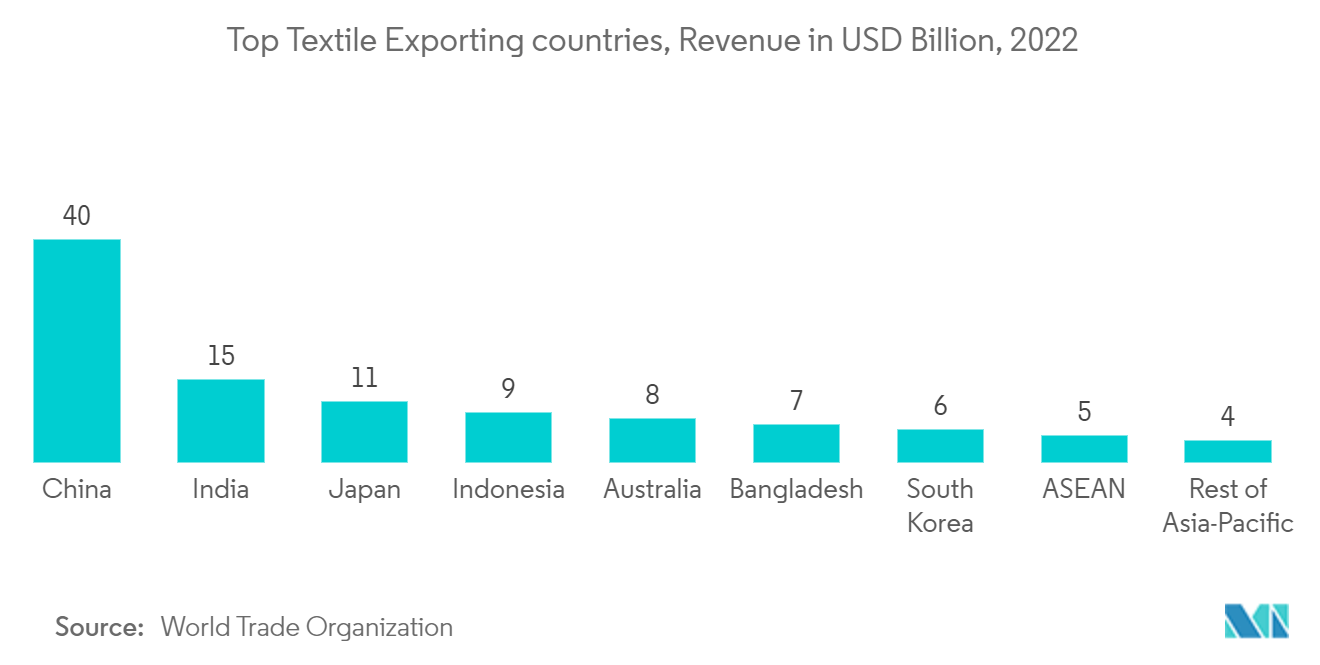
Asia-Pacific Non-Woven Fabric Industry Overview
The Asia-Pacific non-woven fabric market is partially consolidated in nature. Some of the major players in the market (not in any particular order) include DuPont, TORAY INDUSTRIES, INC., Berry Global Inc., Ahlstrom, and Autotech Nonwovens Pvt Ltd, among others.
Asia-Pacific Non-Woven Fabric Market Leaders
-
DuPont
-
TORAY INDUSTRIES, INC.
-
Berry Global Inc.
-
Ahlstrom
-
Autotech Nonwovens Pvt Ltd
*Disclaimer: Major Players sorted in no particular order
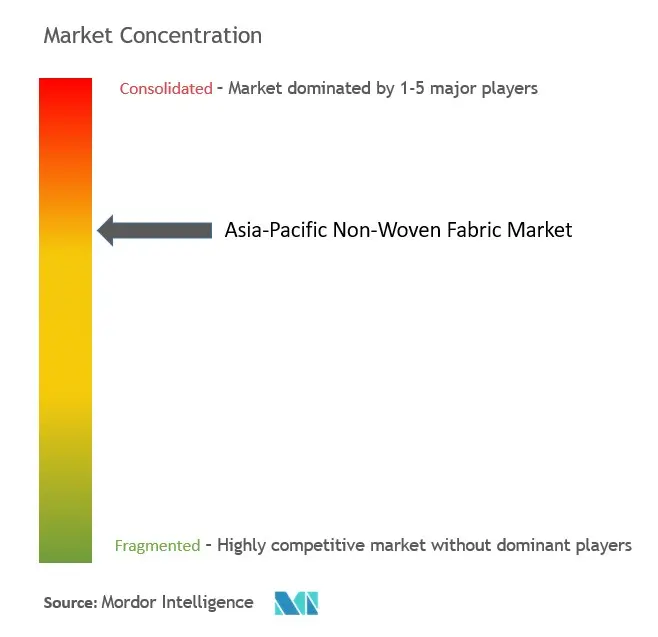
Asia-Pacific Non-Woven Fabric Market News
- November 2022: Fitesa announced the expansion of its production capacity for nonwoven fabrics for medical applications. The company is expected to invest in new machinery to meet the growing demand for these products.
Asia-Pacific Non-Woven Fabric Market Report - Table of Contents
1. INTRODUCTION
- 1.1 Study Assumptions
- 1.2 Scope of the Study
2. RESEARCH METHODOLOGY
3. EXECUTIVE SUMMARY
4. MARKET DYNAMICS
-
4.1 Drivers
- 4.1.1 Increasing Application Base in the Healthcare Industry
- 4.1.2 Growth in The Automotive Industry
- 4.1.3 Increasing Demand for Non-Woven Fabrics in The Textile Industry
-
4.2 Restraints
- 4.2.1 Lack of Awareness Among Consumers
- 4.2.2 Volatility in Raw Material Prices
- 4.3 Industry Value Chain Analysis
-
4.4 Porter's Five Forces Analysis
- 4.4.1 Bargaining Power of Suppliers
- 4.4.2 Bargaining Power of Buyers
- 4.4.3 Threat of New Entrants
- 4.4.4 Threat of Substitute Products and Services
- 4.4.5 Degree of Competition
5. MARKET SEGMENTATION (Market Size in Value)
-
5.1 Technology
- 5.1.1 Spun-Bond
- 5.1.2 Wet Laid
- 5.1.3 Dry Laid
- 5.1.4 Others (Electrostatic spinning, Flash-spun, etc.)
-
5.2 Material
- 5.2.1 Polyester
- 5.2.2 Polypropylene
- 5.2.3 Polyethylene
- 5.2.4 Rayon
- 5.2.5 Others (Wood Pulp, Bio-Component, etc.)
-
5.3 End-User Industry
- 5.3.1 Construction
- 5.3.2 Textiles
- 5.3.3 Healthcare
- 5.3.4 Automotive
- 5.3.5 Others (Personal Care, Consumer Goods, etc.)
-
5.4 Geography
- 5.4.1 China
- 5.4.2 India
- 5.4.3 Japan
- 5.4.4 South Korea
- 5.4.5 Indonesia
- 5.4.6 Malaysia
- 5.4.7 Thailand
- 5.4.8 Vietnam
- 5.4.9 Rest of Asia-Pacific
6. COMPETITIVE LANDSCAPE
- 6.1 Mergers and Acquisitions, Joint Ventures, Collaborations, and Agreements
- 6.2 Market Share (%)**/Ranking Analysis
- 6.3 Strategies Adopted by Leading Players
-
6.4 Company Profiles
- 6.4.1 Ahlstrom
- 6.4.2 Autotech Nonwovens Pvt Ltd
- 6.4.3 Berry Global Inc.
- 6.4.4 Cygnus Group
- 6.4.5 DuPont
- 6.4.6 Eximius Innovative Pvt. Ltd.
- 6.4.7 Fitesa S.A.
- 6.4.8 Freudenberg Performance Materials
- 6.4.9 Ginni Filaments
- 6.4.10 Glatfelter Corporation
- 6.4.11 Global Non Wovens Limited
- 6.4.12 Johns Manville
- 6.4.13 Reliance Non-woven Industry LLC
- 6.4.14 TORAY INDUSTRIES, INC.
- *List Not Exhaustive
7. MARKET OPPORTUNITIES AND FUTURE TRENDS
- 7.1 Rising Awareness Regarding Hygiene and Personal care
- 7.2 Other Opportunities
Asia-Pacific Non-Woven Fabric Industry Segmentation
Non-woven fabrics are broadly defined as sheet or web structures bonded together by entangling fiber or filaments mechanically, thermally, or chemically. They are flat, porous sheets made directly from separate fibers or molten plastic or plastic film.
The Asia-Pacific non-woven fabric market is segmented by technology, material, end-user industry, and geography. By technology, the market is segmented into spun-bond, wet-laid, dry-laid, and others (electrostatic spinning, flash-spun, etc.). By material, the market is segmented into polyester, polypropylene, polyethylene, rayon, and others (wood pulp, bio-component, etc.). By end-user industry, the market is segmented into construction, textiles, healthcare, automotive, and others (personal care, consumer goods, etc.). The report offers market size and forecasts for 8 major countries across the region. For each segment, the market sizing and forecasts are provided in terms of value (USD).
| Technology | Spun-Bond |
| Wet Laid | |
| Dry Laid | |
| Others (Electrostatic spinning, Flash-spun, etc.) | |
| Material | Polyester |
| Polypropylene | |
| Polyethylene | |
| Rayon | |
| Others (Wood Pulp, Bio-Component, etc.) | |
| End-User Industry | Construction |
| Textiles | |
| Healthcare | |
| Automotive | |
| Others (Personal Care, Consumer Goods, etc.) | |
| Geography | China |
| India | |
| Japan | |
| South Korea | |
| Indonesia | |
| Malaysia | |
| Thailand | |
| Vietnam | |
| Rest of Asia-Pacific |
Asia-Pacific Non-Woven Fabric Market Research FAQs
How big is the Asia-Pacific Non-Woven Fabric Market?
The Asia-Pacific Non-Woven Fabric Market size is expected to reach USD 36.76 billion in 2024 and grow at a CAGR of greater than 8% to reach USD 38.44 billion by 2029.
What is the current Asia-Pacific Non-Woven Fabric Market size?
In 2024, the Asia-Pacific Non-Woven Fabric Market size is expected to reach USD 36.76 billion.
Who are the key players in Asia-Pacific Non-Woven Fabric Market?
DuPont, TORAY INDUSTRIES, INC., Berry Global Inc., Ahlstrom and Autotech Nonwovens Pvt Ltd are the major companies operating in the Asia-Pacific Non-Woven Fabric Market.
What years does this Asia-Pacific Non-Woven Fabric Market cover, and what was the market size in 2023?
In 2023, the Asia-Pacific Non-Woven Fabric Market size was estimated at USD 33.82 billion. The report covers the Asia-Pacific Non-Woven Fabric Market historical market size for years: 2019, 2020, 2021, 2022 and 2023. The report also forecasts the Asia-Pacific Non-Woven Fabric Market size for years: 2024, 2025, 2026, 2027, 2028 and 2029.
Asia Pacific Industrial Nonwovens Fabric Industry Report
Statistics for the 2024 Asia Pacific Industrial Nonwovens Fabric market share, size and revenue growth rate, created by Mordor Intelligence™ Industry Reports. Asia Pacific Industrial Nonwovens Fabric analysis includes a market forecast outlook 2029 and historical overview. Get a sample of this industry analysis as a free report PDF download.



